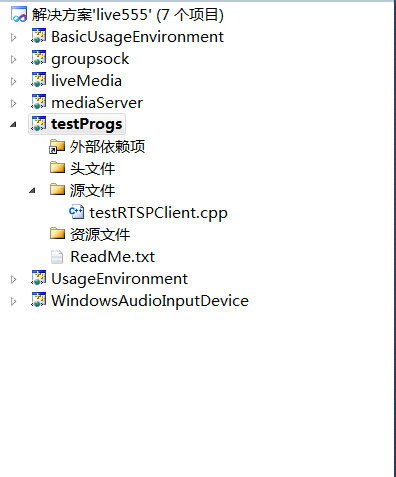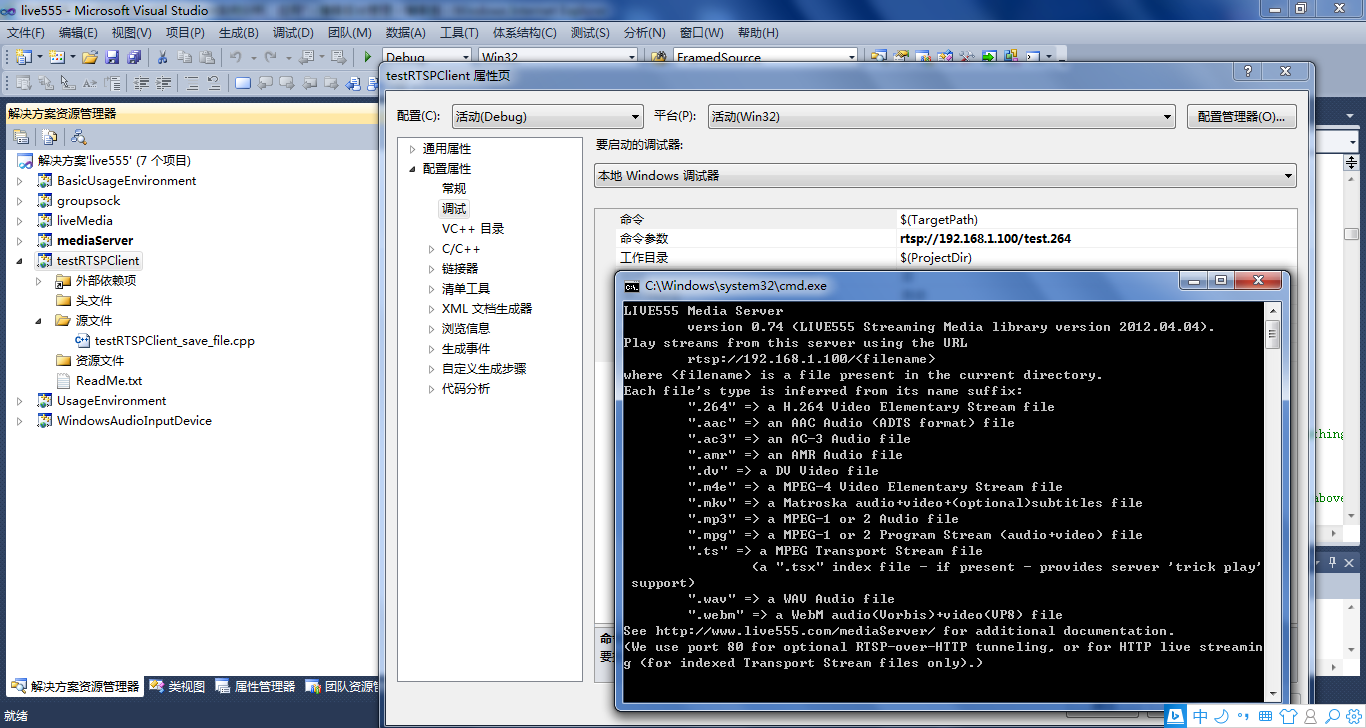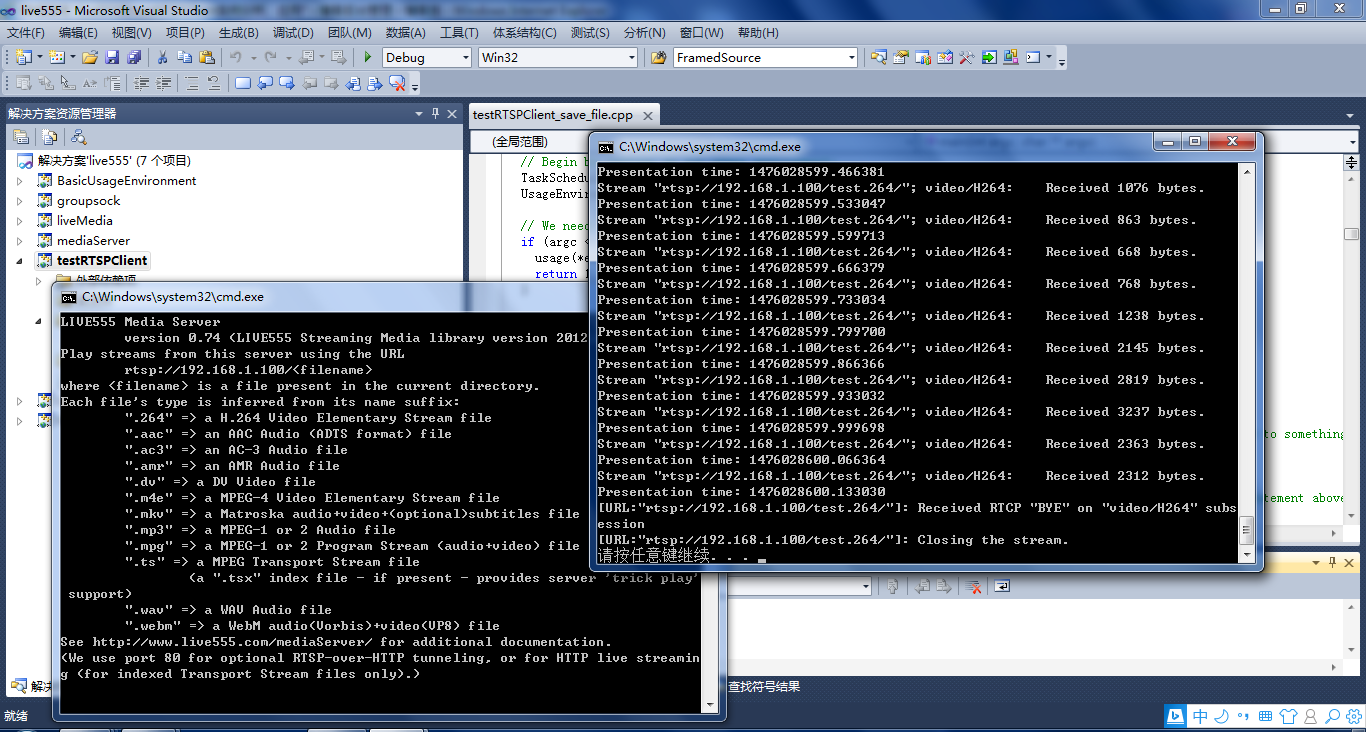RTSP客户端接收存储数据(live555库中的testRTSPClient实例)
1、testRTSPClient简介
testRTSPClient是个简单的客户端实例,这个实例对rtsp数据交互作了详细的描述,其中涉及到rtsp会话的两个概念Source和Sink.
Source是生产数据,Sink是消费数据.
testRTSPClient非常简洁,除了接收服务端发送过来的数据,什么都没干,所以我们很方便在这个基础上改造,做我们自己的项目.
2、testRTSPClient编译,运行
在linux下编译运行更方便,鉴于我的电脑太渣,虚拟机跑起来费劲,就转到windows下来折腾.
在windows下只需要加载这一个文件就可以编译,我们以mediaServer为服务端,以testRTSPClient为客户端。
当然也可以用支持rtsp协议的摄像机或其他实体设备作为服务端。


先启动mediaServer,然后在testRTSPClient项目的命令菜单里填入mediaServer 提示的IP, 再启动testRTSPClient即可。


3、testRTSPClient核心代码解读
1)看代码之前可以大致浏览一下总体的框架,这位博主画了个流程图http://blog.csdn.net/smilestone_322/article/details/17297817
void DummySink::afterGettingFrame(unsigned frameSize, unsigned numTruncatedBytes,
struct timeval presentationTime, unsigned /*durationInMicroseconds*/) {
// We've just received a frame of data. (Optionally) print out information about it:
#ifdef DEBUG_PRINT_EACH_RECEIVED_FRAME
if (fStreamId != NULL) envir() << "Stream \"" << fStreamId << "\"; ";
envir() << fSubsession.mediumName() << "/" << fSubsession.codecName() << ":\tReceived " << frameSize << " bytes";
if (numTruncatedBytes > 0) envir() << " (with " << numTruncatedBytes << " bytes truncated)";
char uSecsStr[6+1]; // used to output the 'microseconds' part of the presentation time
sprintf(uSecsStr, "%06u", (unsigned)presentationTime.tv_usec);
envir() << ".\tPresentation time: " << (unsigned)presentationTime.tv_sec << "." << uSecsStr;
if (fSubsession.rtpSource() != NULL && !fSubsession.rtpSource()->hasBeenSynchronizedUsingRTCP()) {
envir() << "!"; // mark the debugging output to indicate that this presentation time is not RTCP-synchronized
}
envir() << "\n";
#endif // Then continue, to request the next frame of data:
continuePlaying();
} Boolean DummySink::continuePlaying() {
if (fSource == NULL) return False; // sanity check (should not happen) // Request the next frame of data from our input source. "afterGettingFrame()" will get called later, when it arrives:
fSource->getNextFrame(fReceiveBuffer, DUMMY_SINK_RECEIVE_BUFFER_SIZE,
afterGettingFrame, this,
onSourceClosure, this);
return True;
}
2)有网友在testRTSPClient基础上,把接收的数据写成h264文件了http://blog.csdn.net/occupy8/article/details/36426821
void DummySink::afterGettingFrame(void* clientData, unsigned frameSize, unsigned numTruncatedBytes,
struct timeval presentationTime, unsigned durationInMicroseconds) {
DummySink* sink = (DummySink*)clientData;
sink->afterGettingFrame(frameSize, numTruncatedBytes, presentationTime, durationInMicroseconds);
} // If you don't want to see debugging output for each received frame, then comment out the following line:
#define DEBUG_PRINT_EACH_RECEIVED_FRAME 1 void DummySink::afterGettingFrame(unsigned frameSize, unsigned numTruncatedBytes,
struct timeval presentationTime, unsigned /*durationInMicroseconds*/) {
// We've just received a frame of data. (Optionally) print out information about it:
#ifdef DEBUG_PRINT_EACH_RECEIVED_FRAME
if (fStreamId != NULL) envir() << "Stream \"" << fStreamId << "\"; ";
envir() << fSubsession.mediumName() << "/" << fSubsession.codecName() << ":\tReceived " << frameSize << " bytes";
if (numTruncatedBytes > 0) envir() << " (with " << numTruncatedBytes << " bytes truncated)";
char uSecsStr[6+1]; // used to output the 'microseconds' part of the presentation time
sprintf(uSecsStr, "%06u", (unsigned)presentationTime.tv_usec);
envir() << ".\tPresentation time: " << (unsigned)presentationTime.tv_sec << "." << uSecsStr;
if (fSubsession.rtpSource() != NULL && !fSubsession.rtpSource()->hasBeenSynchronizedUsingRTCP()) {
envir() << "!"; // mark the debugging output to indicate that this presentation time is not RTCP-synchronized
}
envir() << "\n";
#endif //todo one frame
//save to file
if(!strcmp(fSubsession.mediumName(), "video"))
{
if(firstFrame)
{
unsigned int num;
SPropRecord *sps = parseSPropParameterSets(fSubsession.fmtp_spropparametersets(), num);
// For H.264 video stream, we use a special sink that insert start_codes:
struct timeval tv= {0,0};
unsigned char start_code[4] = {0x00, 0x00, 0x00, 0x01};
FILE *fp = fopen("test.264", "a+b");
if(fp)
{
fwrite(start_code, 4, 1, fp);
fwrite(sps[0].sPropBytes, sps[0].sPropLength, 1, fp);
fwrite(start_code, 4, 1, fp);
fwrite(sps[1].sPropBytes, sps[1].sPropLength, 1, fp);
fclose(fp);
fp = NULL;
}
delete [] sps;
firstFrame = False;
} char *pbuf = (char *)fReceiveBuffer;
char head[4] = {0x00, 0x00, 0x00, 0x01};
FILE *fp = fopen("test.264", "a+b");
if(fp)
{
fwrite(head, 4, 1, fp);
fwrite(fReceiveBuffer, frameSize, 1, fp);
fclose(fp);
fp = NULL;
}
} // Then continue, to request the next frame of data:
continuePlaying();
} Boolean DummySink::continuePlaying() {
if (fSource == NULL) return False; // sanity check (should not happen) // Request the next frame of data from our input source. "afterGettingFrame()" will get called later, when it arrives:
fSource->getNextFrame(fReceiveBuffer, DUMMY_SINK_RECEIVE_BUFFER_SIZE,
afterGettingFrame, this,
onSourceClosure, this);
return True;
}
testRTSPClient接收的fReceiveBuffer缓存没有起始码,start_code[4] = {0x00, 0x00, 0x00, 0x01}; 写成文件或者播放都需要自行加上。
3)testRTSPClient这个实例还支持多路录放,网上搜到有人已经实现了,搬过来.
http://blog.chinaunix.net/uid-15063109-id-4482932.html
——缺什么补什么
RTSP客户端接收存储数据(live555库中的testRTSPClient实例)的更多相关文章
- RTSP客户端接收存储数据(live555库中的openRTSP实例)
一.openRTSP编译运行 a)windows下编译运行 还是以mediaServer作为服务端,openRTSP作为客户端 b)Linux下编译运行 转自http://kuafu80.blog.1 ...
- live555库中的testRTSPClient实例
1.testRTSPClient简介 testRTSPClient是个简单的客户端实例,这个实例对rtsp数据交互作了详细的描述,其中涉及到rtsp会话的两个概念Source和Sink. Source ...
- live555库中的openRTSP实例
一.openRTSP编译运行 a)windows下编译运行 还是以mediaServer作为服务端,openRTSP作为客户端 b)Linux下编译运行 转自http://kuafu80.blog.1 ...
- live555库中的testH264VideoStreamer实例
1.h264文件的推送 testH264VideoStreamer.cpp文件的开头就定义了 char const* inputFileName = "test.264"; 后面接 ...
- JVM存储位置分配——java中局部变量、实例变量和静态变量在方法区、栈内存、堆内存中的分配
Java中的变量根据不同的标准可以分为两类,以其引用的数据类型的不同来划分可分为“原始数据类型变量和引用数据类型变量”,以其作用范围的不同来区分可分为“局部变量,实例变量和静态变量”. 根据“Java ...
- RTSP服务端转发服务(live555库中的testH264VideoStreamer.cpp和testOnDemandRTSPServer.cpp实例)
1.h264文件的推送 testH264VideoStreamer.cpp文件的开头就定义了 char const* inputFileName = "test.264"; 后面接 ...
- 【JAVA】使用 jedis操作redis——连接、存储数据、切库等
本篇运用Java调用jedis包(jedis在线文档API ),做简单操作实例. 安装jedis 1. 2.9.0 jar 版本下载: jedis-2.9.0.jar 2. 新建项目,添加该驱动包 连 ...
- 转 RTSP客户端模拟器(TCP方式,Python实现)
转自: http://www.cnblogs.com/MikeZhang/archive/2012/10/29/rtspTcpClient_DSS_20121029.html 由于某种需求,工作中需要 ...
- Netty 如何高效接收网络数据?一文聊透 ByteBuffer 动态自适应扩缩容机制
本系列Netty源码解析文章基于 4.1.56.Final版本,公众号:bin的技术小屋 前文回顾 在前边的系列文章中,我们从内核如何收发网络数据开始以一个C10K的问题作为主线详细从内核角度阐述了网 ...
随机推荐
- HTML5七巧板canvas绘图
<!DOCTYPE html> <html xmlns="http://www.w3.org/1999/xhtml"> <head> <m ...
- iOS swift HandyJSON组合Alamofire发起网络请求并转换成模型
在swift开发中,发起网络请求大部分开发者应该都是使用Alamofire发起的网络请求,至于请求完成后JSON解析这一块有很多解决方案,我们今天这里使用HandyJSON来解析请求返回的数据并转化成 ...
- 删除Win10的OneDrive
1.运行 -> gpedit.msc 计算机配置 -> 管理模板 -> Windows组件 -> OneDrive -> 禁止使用OneDrive进行文件储存 -> ...
- phpcms 初次建站心得
最近要给客户建个网站,考虑到效率问题,直接找了个开源的phpcms,(现在被收购了,以前的时候我还知道是个开源的).由于对这个东西不熟悉,原来就是了解一些,php的建站系统,php的MVC框架.故此, ...
- 微信小程序上传一或多张图片
一.要点 1.选取图片 wx.chooseImage({ sizeType: [], // original 原图,compressed 压缩图,默认二者都有 sourceType: [], // a ...
- android之ViewPager修改滑动速度
在android中,使用过viewpager的人都清楚,我们如果使用viewpager进行滑动时,如果通过手指滑动来进行的话,可以根据手指滑动的距离来实现,但是如果通过setCurrentItem函数 ...
- 【ARDUINO】HC-05蓝牙不配对问题
除了刷主从之外,不配对的原因有1:已经配对其他设备,需用AT+RMAAD来移除.2.默认为蓝牙由绑定指令设置,需改为任意地址连接模式AT+CMODE=1 //#define AT 2 #define ...
- 第10步:DBCA创建实例
注意,创建磁盘组时需要以oracle用户身份执行,在那之前可能需要以root身份执行xhost+,即命令: 代码1 [root@sgdb1~]# xhost+ [root@sgdb1~]# su - ...
- (1)、hive框架搭建和架构简介
一.简介 Hive是基于hadoop的一个数据仓库工具,有助于查询和管理分布式存储系统中的数据集,非常适合数据仓库的统计分析 Hive 不适合用于连机事物处理.也不提供实时查询,比较适合在大量不可变数 ...
- Eclipse设置护眼背景
Window-->Preferences-->General-->Editors-->Text Editors-->Background color 自定义颜色:色调:8 ...
